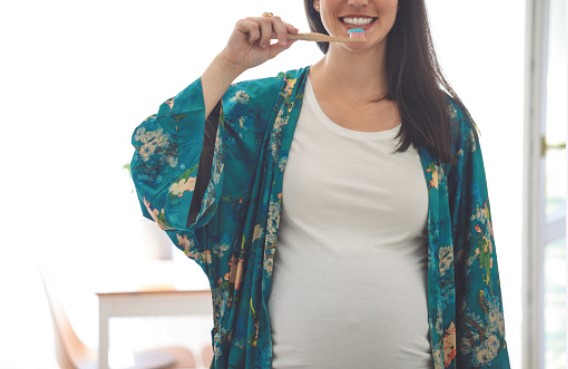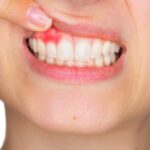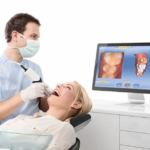
Periodontal Disease and Pregnancy
During pregnancy, there are changes in hormone levels which promote an inflammatory response that increases the risk of developing periodontal disease (2).
What is periodontal disease?
Periodontal disease is an infection of the gums and the tissues that hold your teeth in place (National Institute of Dental and Craniofacial Research, 2018). It is usually caused by poor oral hygiene habits that allow plaque (a sticky film of bacteria) to build up on the teeth and harden. The bacteria that is in our mouth is continuously forming plaque which can be removed by proper brushing/flossing habits; however, if it is not removed, the plaque will harden and turn into tartar.
Pregnancy-induced gingivitis is the most common form of periodontal disease during pregnancy and may show as gum inflammation, redness, and bleeding (2[LG1] ). 60-70% of pregnant women experience pregnancy gingivitis (Procter & Gamble, 2020). The systemic inflammation caused by periodontal disease can play a role in adverse pregnancy outcomes such as delivering preterm and delivering a child with low birth weight (2).
Researchers believe that bacteria from periodontal disease eventually reach the placenta which can affect the structural integrity of the placenta and trigger preterm birth (2). One study found that women with periodontitis have a 3.2 times higher risk of delivering a baby with low birth weight and have a 3.4 times higher risk of delivering preterm (3).
How Future Moms Can Prevent Periodontal Disease
Periodontal disease can be prevented through good oral hygiene habits and routine dental cleanings. Good oral hygiene habits include brushing after meals to remove debris and plaque. It is also important to brush your tongue to remove bacteria that gathers there.
Also, flossing at least once a day to remove food particles and plaque that are stuck between the teeth where a toothbrush cannot reach. Routine dental cleanings are also essential in preventing periodontal disease due to the fact that professional dental cleanings are the only way to remove the tartar that contributes to the development of periodontal disease.
Works Cited
(1) Gum (Periodontal) Disease Causes, Symptoms, Diagnosis, Treatment. (n.d.). Retrieved November 01, 2020, from https://www.nidcr.nih.gov/health-info/gum-disease/more-info
(2) Kierce, E., & Rainchuso, L. (2017, November 08). Oral Health’s Involvement in Adverse Birth Outcomes. Retrieved November 01, 2020, from https://decisionsindentistry.com/article/oral-healths-involvement-adverse-birth-outcomes/
(3) Meqa, K., Dragidella, F., Disha, M., & Sllamniku-Dalipi, Z. (2017, March). The Association between Periodontal Disease and Preterm Low Birthweight in Kosovo. Retrieved November 01, 2020, from https://www.ncbi.nlm.nih.gov/pmc/articles/PMC5506254/
(4) Organization. (n.d.). Pregnancy Gingivitis: Symptoms & Treatments During Pregnancy. Retrieved November 01, 2020, from https://oralb.com/en-us/oral-health/conditions/gums/pregnancy-gingivitis-symptoms-treatments
[LG1]Will link to the reference from the article in all references


